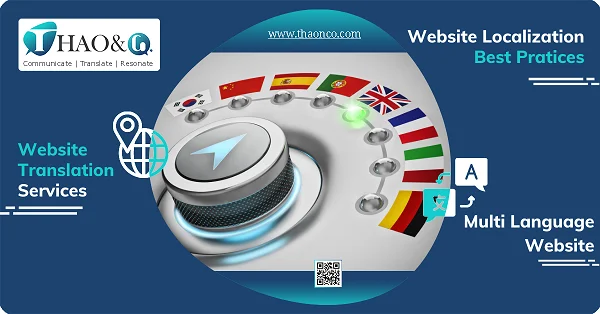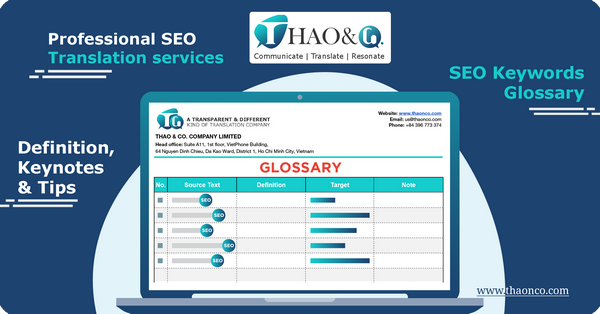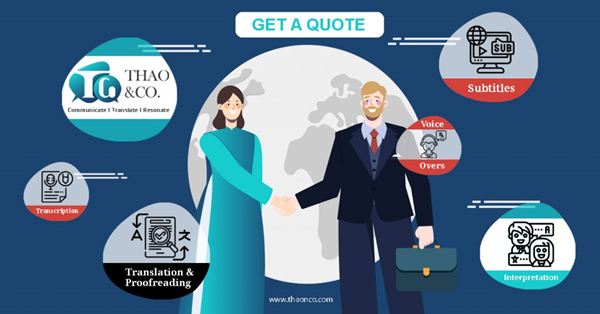The website localization process involves multiple stages, each requiring precision and an eye for detail. Therefore, experts are required to possess extensive knowledge and years of experience. This article includes 7 website localization best practices gathered from professional translators.
Translation is the linguistic conversion from one language to another. Initially, translation is often carried out on documents, certificates, contracts, or various types of documents. With the advancement of technology, translation is now applied to digital formats such as websites, printed materials, Word files, PDFs, video subtitles, and more.
You need to distinguish between translation and localization. Translation and localization both involve converting text elements from one language to another. While translation purely focuses on translating words to their equivalences in the target language, localization goes a step further by modifying the translation and/or integrating new textual, graphical, audio, etc. elements to make the final product better resonate with the culture and preferences of customers. Translation demands precision and careful attention to each word, while localization calls for cultural and linguistic appropriateness.
Website localization is the linguistic conversion of a website. If done correctly, the content on the website will be displayed in another language with accurate information and of a linguistic style that suits customers in the target market. From there, websites can reach more customers, helping businesses expand the market, and bringing benefits in terms of promotion, sales, and more.
Localizing a website involves addressing MANY issues and challenges. Websites are categorized into different types, such as news websites, e-commerce websites, business websites, and so on. Each website will have multiple pages with each page containing various components.
In addition, a website’s content extends beyond words and texts to include graphical, audio, etc. elements. Therefore, translators need practical experience in website localization to ensure the best results.

The ideal condition for localizing a website is to plan right from the start of the website development. Preparation involves various tasks, including defining the website’s goals, target audience, reach, design, interface, posted content, and more. The more thorough the preparation process is, the more effective the translation will be.
For websites not designed to be displayed in multiple languages, additional adjustments are necessary. Furthermore, during the content localization process, there will be interface and layout changes that need to be modified to align with the target market. The implementation process is relatively complex, requiring a specialized team and effective website localization practices.
Each type of website serves distinct purposes, caters to specific audiences, and targets different regions. Right from the preparation phase, you should clearly define your goals and expectations when launching a website. This will help the translation team understand and conduct accurate analysis to convey your message to the intended audience effectively.
A consideration when translating a website is the choice between machine translation and human translation. Both methods have their own pros and cons with unique cases of application. If you are still undecided, here is what you need to know about these two methods.
Machine translation is a method of translating a website using readily-available tools. The most popular one today is Google Translate. This is considered a quick and simple approach, requiring minimal time and effort.
For websites on the WordPress platform, automatic machine translation can be integrated using various plugins. However, the drawback is that machine translations may produce unnatural, poor SEO-optimized translations, resulting in a bad user experience.

Human translation is a professional method of translating a website that can overcome the drawbacks of machine translation. Human translation is typically performed by professional translators with a meticulous proofreading process.
Furthermore, the translation can be put through another localization process to further optimize the interface and other elements on the website. Combining these two processes can ensure the website delivers the best customer experience, is better ranked on search engines, and conveys the intended message.
Although human translation has many advantages over machine translation, there still exist certain limitations to consider. Firstly, producing the best translation requires investing a considerable amount of time in thorough and meticulous preparation.
Furthermore, human translation needs to be carried out by experts with adequate expertise and experience. Therefore, it is recommended that you opt for a reputable and high-quality translation agency.
One of the crucial website localization practices that cannot be overlooked is leaving room for management and future edits. Websites often have folders to store language files. Especially for WordPress source code websites, you can find .po or .pot files. In cases where there is no language file, you will need to create a separate file.
Using a dedicated source file can help control all the elements on the website. In addition, translations stored in a separate file are easier to manage, edit, and replace. During the editing process, it’s advisable to regularly back up data to minimize risks and errors.

SEO is a top priority for any website marketing activites. To optimize the website’s reach, website translators need to have a firm grasp of SEO knowledge. Thus, your web content will be optimized for keyword research, improving search rankings, and bringing in free traffic.
You need to pay attention to some SEO-related tasks such as content localization strategy, keyword glossary, SEO content planning, link building, interface design, and social media engagement. In addition to translating website content, it’s important to localize elements such as URL, SEO title, and Meta tags. Because these are criteria that search engines like Google use to analyze and rank websites.
Best website localization practices from various experts show that, in some cases, the website may need a change in interface. This will help enhance the user experience when reaching out to new target customer groups. In addition, meeting standards for display on mobile devices is also crucial.
For some languages, a wider text field may be needed, or certain languages are written from right to left, such as Arabic. Therefore, website localization does not only involve translating content but also checking the design, interface, and layout to ensure compatibility with the target market.
An effective practice in website translation is to conduct localization testing. Website localization is a multi-step process that includes keyword and terminology research, translation and proofreading of content, analysis, evaluation, integration of translations, and more. The role of localization goes beyond translation; it helps bring the website closer to the target audience.
A localized website will feel more natural and more relatable to potential customers in the target region. Furthermore, SEO optimization helps the website easily achieve high rankings on search engines. Localized websites also offer a more friendly user experience, giving you a competitive edge over competitors.
To make a bilingual or multilingual website appeal to international customers, translations need to be accurate while conveying the original message. In addition, the website interface and layout must provide the best user experience, which is not a simple task.
Understanding these challenges, Thao & Co. has made it our goal to become a linguistic bridge, assisting organizations and individuals in achieving effective communication and conveying messages to every market worldwide.
The professional website translation services provided by our agency have received a great deal of attention from businesses looking to expand their market and develop international business. With a team of native professional linguists with many years of experience in website translation, you can trust the quality of our translations.

Furthermore, Thao & Co. has also received high praise for our professional and innovative working style. We utilize modern technologies to build a proprietary platform that helps customers easily track translation progress, communicate directly with the project management team, and view expert profiles.
With countless projects under our belt, Thao & Co. can meet all website localization needs and seamlessly integrate custom translations directly into the system, from programming languages like PHP, C++, Python,… to CMS platforms like WordPress, Joomla, or Magento.
With a team of programmers and experienced linguists, Thao & Co. provides Custom Integration and Linguistic Review services. This involves directly integrating one or more new languages into the website after our team of translators has completed the translation. At the same time, programmers at Thao & Co. ensure the smooth operation of the website, maintaining the structural integrity and aesthetic interface.
Custom Integration is a solution chosen by many businesses when translating and localizing websites. Manual integration can make the translation natural and context-appropriate, enhancing user experience, improving security, and providing various long-term benefits.
There are many things to consider when localizing a website. Developing a comprehensive multilingual website that meets your business needs is far from an easy task.
This article summarizes some important rules for reference. To receive more in-depth answers and consultation on website translation and localization, feel free to contact Thao & Co.